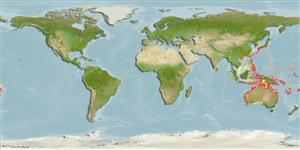Environment / Climate / Range
Ecology
Marine; demersal. Tropical, preferred ?
Eastern Indian Ocean to Western Pacific: Australia and Indonesia.
Size / Weight / Age
Maturity: Lm ? range ? - ? cm
Max length : 45.0 cm TL male/unsexed; (Ref. 3132); max. published weight: 5.0 kg (Ref. 3132)
This species is distinguished by the following characters: a single small isolated dorsal spine anteriorly; second dorsal and anal fin rays usually 13; snout long, 28.5-31.0% HL; larger specimens with interorbit narrow 7.7-12.0% HL; postorbital short, 50.7-56.4% HL; posterior portion of snout and interorbital covered with scales; upper iris lappet triangular; skinny sensory tubes from the suborbital bones and preopercle not covering the cheek region; preopercule with 2 spines, the lower slightly longer than the upper; fingerlike interopercular flap; a single exterior opening of the lateral line scales; head and body pale brown, with many small brownish spots dorsally, 4 or more dark longitudinal bands on caudal fin, and upper lobe of caudal fin lacking yellow blotch when fresh (Ref. 86914).
Found on sand bottoms (Ref. 3132). Neither anterolateral glandular groove nor venom gland is present (Ref. 57406).
Life cycle and mating behavior
Maturity | Reproduction | Spawning | Eggs | Fecundity | Larvae
Imamura, H., 2008. Synonymy of two species of the genus Platycephalus and validity of Platycephalus westraliae (Teleostei: Platycephalidae). Ichthyol. Res. 55:399-406. (Ref. 86914)
IUCN Red List Status (Ref. 115185)
CITES (Ref. 94142)
Not Evaluated
Human uses
More information
Common namesSynonymsMetabolismPredatorsEcotoxicologyReproductionMaturitySpawningFecundityEggsEgg development
Age/SizeGrowthLength-weightLength-lengthLength-frequenciesMorphometricsMorphologyLarvaeLarval dynamicsRecruitmentAbundance
ReferencesAquacultureAquaculture profileStrainsGeneticsAllele frequenciesHeritabilityDiseasesProcessingMass conversion
Tools
Special reports
Download XML
Internet sources
